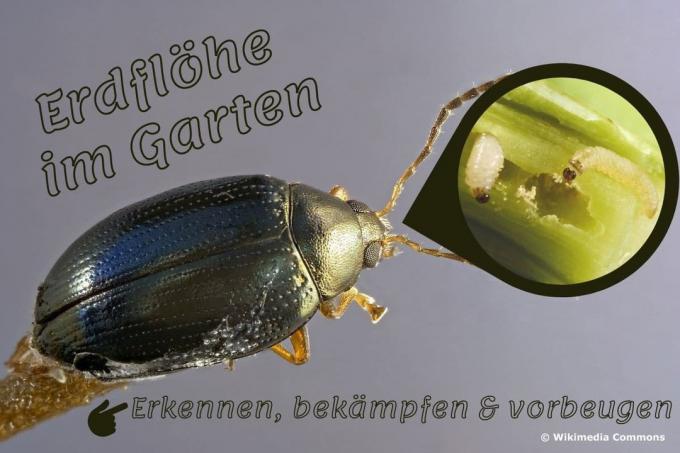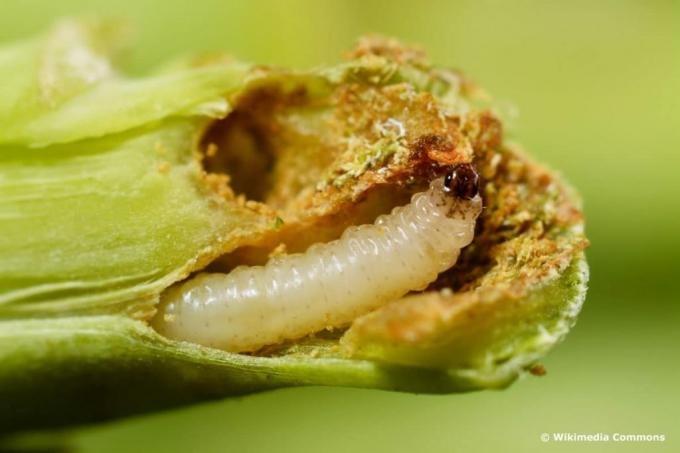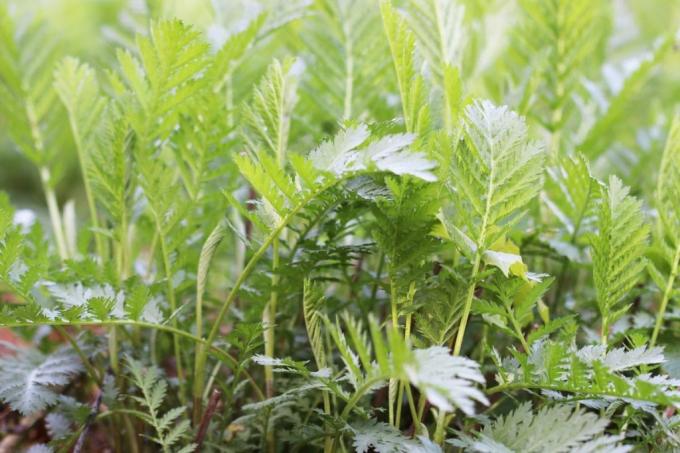
table of contents
- What are earth fleas?
- Damage image
- Affected plants
- Fight
- Prevent
- frequently asked Questions
Earth fleas are pests that often go unnoticed because they are so small that they don't attract attention. In doing so, they can damage young plants so much that they die.
In a nutshell
- Earth fleas belong to the leaf beetles
- they live in dry soil and feed on leaf and root tissue
- Overwinter between mulch, wood or in stone piles
- Young plants in particular are at risk
- Preventive measures are most important
What are earth fleas?
Despite the name, earth fleas have nothing in common with common fleas. They belong to the group of leaf beetles and are so small that they are easily overlooked. One characteristic of the beetles, however, is their colorful appearance, which ranges from yellow to red to blue. Most of the time, the beetles also have a metallic sheen. Their hind legs are well developed and actually allow them to jump, although not as far as fleas do.
Damage image
The beetles and larvae feed on both the leaves and the roots. This can be recognized by the fact that the plants take care. The bites in the leaves look like small holes. Sometimes feeding tunnels can also be seen. In older infested plants, the leaves look like shot through. Young plants can completely die off from the bites on the roots.

Source: Gilles San Martin from Namur, Belgium, Psylliodes chrysocephala larva (31827378971), Edited by Plantopedia, CC BY-SA 2.0
Affected plants
The beetles are mostly “specialized” in a certain type of plant. That is why there are, for example, potato fleas (Psylliodes affinis) or rapeseed fleas (Psylliodes chrysocephalus). Overall, however, they can occur on all kinds of plants, including ornamental plants and fruit trees. The following plants in the vegetable garden are particularly badly damaged:
- Cruciferous vegetables: cabbage, arugula, Radishes, radishes
- Nightshade family: tomatoes, Eggplant, Paprika
Note: The young plants of the species mentioned are particularly affected because they still have soft and unprotected shoots and leaves. The beetles and their larvae can completely destroy a young plant population within a very short time.
Fight
It is not necessary to control all earth fleas. This is only important for infected young plants. In this case, however, aids should be used as soon as possible.
Herbal manure wormwood and tansy

A liquid manure made from parts of plants not only drives away the pests, but also strengthens the plants. This is particularly important with earth fleas because the beetles mainly feed on soft plants. Wormwood and tansy work well with these beetles, either used alone or mixed together.
instructions
- About 50 grams of herb are crushed per liter of water.
- Put the plant material in a sufficiently large container. To avoid a strong odor, add a little rock flour.
- Pour the appropriate amount of water on top. Around 10 cm of the edge should remain free, as the liquid manure foams heavily during development.
- Cover the vessel, but not airtight.
- Stir daily. Fermentation starts when the brew starts to foam.
- The liquid manure is ready when the foaming stops.
- Dilute the liquid manure with water before use. Use one part of liquid manure and ten parts of water for this. The agent is filled into a spray bottle and the plants are sprayed dripping wet with it. Or water the plants with it.
- If necessary, repeat the application after a week.
Rock flour / algae lime
Dusting affected plants with rock flour protects them from pitting of the leaves, but not from damage to the roots.
Note: Rock flour or algae lime are also remedies against various fungal diseases on the leaves.
Promote beneficial organisms

All animals that eat insects are welcome as beneficial insects in the vegetable garden. This includes not only the hedgehog, but also shrews and larger species of beetles. There should be enough hiding places for the animal guests.
Glue strips
The small bugs can be caught with glue. For this, wooden boards are coated with glue and placed between the plants. The animals hop or run on the boards and stick. However, it should be noted that other animals could also be caught.
Prevent
The right reactions to a flea infestation can prevent worse, but it is even better if it is prevented early on. First and foremost, it is helpful to take good care of the plants:
- water regularly, the pests do not like moist soil
- Keeping the soil loose, chopping it from time to time, disrupts the development of the beetles
- Mulching prevents penetration into the soil
- need-based fertilization vigorously plants
Other recommended preventive measures are:
Culture protection nets

They are available in different designs, for the tiny beetles the mesh size has to be very small (less than 1 mm). Protective nets only work if they are attached really close to the crop because the pests use every loophole. They also have the disadvantage that they have to be removed and reattached every time the plants are cared for.
Mixed cultures
Combining different types of vegetables serves two purposes. On the one hand, the vapors from the plants can keep pests away, on the other hand, pests are distracted from their actual target. With earth fleas should Mixed cultures work well with spinach. It is also important to change the growing location every year.
Early sowing
In the case of fruit vegetables, it makes sense to only put strong young plants in the open ground, then they are no longer so attractive to fleas. Growing on the windowsill or under glass is suitable for this.
frequently asked Questions
They lay eggs from which larvae hatch and feed on parts of plants. The larvae pupate in the ground. This is why regular hoeing is so important because it disturbs the pupation of the animals and makes it easier for beneficial insects to find the larvae and pupae.
The pests can also penetrate greenhouses or cold frames, but are easier to keep under control there.
They can be attacked by fleas, but the damage is limited and is more of a visual problem.


